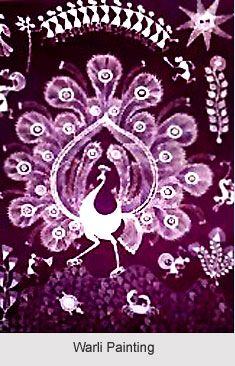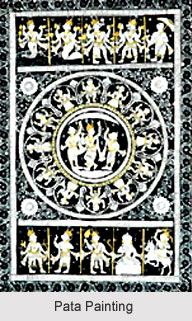 Indian Folk paintings are pictorial expressions of village painters which are marked by the subjects chosen from epics like Ramayana and Mahabharata, Indian Puranasas well as daily village life, birds and animals and natural objects like sun, moon, plants and trees. The colour used expands vast range of vivid vibrant colours to subdued low hues, but mainly derived from the natural material, while papers, clothes, leaves, earthen pots, stone and mud walls are used as canvas. Folk paintings evolved in various region of India depending mainly upon the rural cultures, mythological stories and everyday rituals. The different types of Folk arts are Patas of Bengal and Orissa, Talpatrachitra of Orissa, Madhubani or Mithila style, Rajasthani Painting, Pahari painting, Jain art at Gujarat, Warli paintingsof Maharastra, Thakga, Monpa and different South Indian Folk arts.
Indian Folk paintings are pictorial expressions of village painters which are marked by the subjects chosen from epics like Ramayana and Mahabharata, Indian Puranasas well as daily village life, birds and animals and natural objects like sun, moon, plants and trees. The colour used expands vast range of vivid vibrant colours to subdued low hues, but mainly derived from the natural material, while papers, clothes, leaves, earthen pots, stone and mud walls are used as canvas. Folk paintings evolved in various region of India depending mainly upon the rural cultures, mythological stories and everyday rituals. The different types of Folk arts are Patas of Bengal and Orissa, Talpatrachitra of Orissa, Madhubani or Mithila style, Rajasthani Painting, Pahari painting, Jain art at Gujarat, Warli paintingsof Maharastra, Thakga, Monpa and different South Indian Folk arts.Indian Folk Paintings are so variable from region to region because of the availability of material in different area. Whereas in arid Rajasthan the colours in the folk painting are vibrant and lustrous, painters in colourful Bengal seem to search relief in sober subdued tones. Artists in Orissa pick out palm leaves for painting. While north India found the whitewashed walls for colourful paintings, Oriya artists choose red-clayed wall for white and black paintings.
Indian Folk Paintings of Bengal
Bengal seems to be always far away of court life and the convention of temple art in the paintings. Here the most powerful medium of painting is Pata painting which emerged in the Kalighat area of Kolkataby the Patuas, who used simple bold lines and flat colours to describe the Hindu gods and goddesses like Shiva, Durga, Kali, Krishna, Lakshmi, Ganesha as well as daily rural life. They used to sell the pats in the local market to the pilgrims of Kalighat temple for their earnings. In the 19th century when European art became popular and the sell of Patas reduced, the Patuas selected the same medium to mock westernised civilisation.
 Manasa Mangal, based on Goddess Manasa, has always been a very popular subject and the Pats are used during the song of Manasa in the rural areas. The charms of Manasa Mangal Pats are that they are made on piths. Even today many Patuas in the districts of 24 Parganas, Bankura, Birbhum, Midnapur can be found. They use the basic colours like red, yellow, blue, black and sometimes green and brown. They paint usually on cheapest variety of papers and even on old newspapers, called Jarano Pats which are average 12 to 15 feet in length and one to two feet wide.
Manasa Mangal, based on Goddess Manasa, has always been a very popular subject and the Pats are used during the song of Manasa in the rural areas. The charms of Manasa Mangal Pats are that they are made on piths. Even today many Patuas in the districts of 24 Parganas, Bankura, Birbhum, Midnapur can be found. They use the basic colours like red, yellow, blue, black and sometimes green and brown. They paint usually on cheapest variety of papers and even on old newspapers, called Jarano Pats which are average 12 to 15 feet in length and one to two feet wide.Indian Folk Paintings of Orissa
In Orissa, two types of folk paintings are popular. The first one is Patas. When the pilgrims of Jagannath Temple wanted to buy some memento, Jagannatha pat was their obvious choice. The painters of this are hereditary Chitrakaras, which literally means artists, also known as Maharajas, live close to the temple premises. The other one is palm leaf etching, locally called Talapatrachitra, one of the most ancient forms of art. The idea came while during writing manuscripts some artists felt to decorate it. The palm leaves are cut into standard size and supported by two wooden planks stringed through a hole in the centre. The artists who practice this art live in Puri and Cuttak.
Indian Folk Paintings of Bihar and UP
Madhubani or Mithila art is persistent in some areas of Bihar and Uttar Pradesh, mainly in the districts of Darbhanga and Muzaffarpur, parts of Mongher, Bhagalpur and Saharsa. It is told that the painting evolved when king of Mithila, Janaka, asked the painters to draw the marital ceremony of his daughter Sita with king of Ayodhya, Rama. The village women paint the pictures of Ramayana, Mahabharata, Krishnalila and other Hindu mythologies as well as birds, animals and other natural objects on the mud walls of their hut. In recent times, it is done on paper and clothes. The Santal paintings are simple and rich in colour.
For more visit the link below: